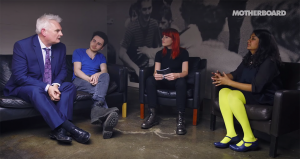
How the connected city can ease urban growing pains
In our latest media partnership, we teamed up with Vice Media’s Motherboard, to explore the pros and perceived cons of the Bristol is Open smart city experiment.
 The resulting 15-minute panel discussion was an interesting watch, and I wanted to take a look at some of the key points.
The resulting 15-minute panel discussion was an interesting watch, and I wanted to take a look at some of the key points.
While a lot of the conversation focussed on security (check out my colleague Alison Vincent’s blog on that here) I wanted to focus on the positives that I believe smart cities will bring to us all.
Our population is already very urban
According to latest census data, 81.5% of the UK population (or 47.5 million people) already live in what’s classed as an urban area. That’s way ahead of a forecast from the UN which estimates 66% of the world’s population will be urban dwellers by the year 2050. We’re moving to a city-living world. The UN also forecasts we’ll have 41 mega-cities by 2030, each with more than 10 million inhabitants.
In the UK, this brings its own unique set of opportunities to accelerate the development of so-called smart cities. According to Frost and Sullivan, there’ll be more than 26 global cities defined as ‘smart’ by 2025, with more than half in Europe and North America.
If more people are living in cities, more people can benefit. It also means we have to think carefully about the best ways of making these cities more connected. And let’s not forget our cities first emerged – largely organically and without specific design – hundreds, if not thousands of years ago.
By bringing together pervasive connectivity, along with the right applications, we can then start to make sense of all the potential information and data points in a thriving city. Why bother?
Steven Johnson wrote a fascinating book called Where Good Ideas Come From: The Natural History of Innovation (check out Johnson’s TED talk on this here). He argues that the best ideas and innovations come from urban areas, and ideas that spark off other ideas. It’s important we do everything we can to join a city up, making it more productive, and more creative.
Making sense of all that data
Control rooms are going to be key to making this happen. Backed up by strong data analytics and (eventually) machine learning, we can start to create extra layers of intelligence.
Smart lighting, for example, can help make a city feel safer while at the same cut down on power usage, and running costs.
Immediacy is also important. There’s no point acting on data if the information is out of date by the time it’s put to use. Having the right applications in place can filter out the noise, and spot emerging trends.
A working example of this could be poor air quality, and how a city looks to redirect traffic. The data has to be actionable straight away. As well as advising people to avoid a traffic jam, people with respiratory problems can also be warned to stay away from certain areas, or take alternative routes. In some situations it’s critical for the data to be as near-real time as possible.
All that data is there right now; it’s just not very well connected at the moment.
Turning those actions into outcomes
Bristol is Open, which features in the Vice video, gives citizens a say in what their smart city does for them.
If we are to overcome challenges and barriers such as security and privacy, it’s massively important to engage the public in this conversation. People have the right to understand what a smart city is, and how it can benefit them.
There’s also a strong case for opening up anonymised and aggregated data sets that are owned by government and large companies, such as train operators or healthcare firms. If we can capture, interpret and correlate data from sensors, other IoT devices and existing data sets, we’ll be able to make significant strides forward.
Right now, for most people they don’t know or they simply don’t care.
Instead, the discussion has to focus on the benefits connected cities can bring. Cleaner air, fewer potholes, less crime…these are all desirable consequences that people would say yes to.
The technology on its own won’t change lives, but it does have a wider positive impact such reducing pollution and making a city safer. The case is made stronger when a direct link can be made for example, between a fall in hospital admissions and improved air quality, or saying the smart city has boosted the economy.
As we become more urbanised as a society, there are going to be numerous challenges. To me the smart city is offering a lot of the answers to those already.
Watch the full Vice Motherboard film The City That Has Its Own Operating System below, and let me know your thoughts in the comments.
Tags:2 Comments





Great insight to emerging digital cities, Stu. The video also explains almost all the concerns today’s citizens would have in mind ahead of the fully connected cities’ rise.
Thanks Ersel. Security is critical to the success of any connected community. As more and more devices are connected it will be critical that people trust these ‘things’. Without the trust many smart city projects will fail.
The other really important factor which has to be carefully considered is how we engage citizens in these projects. Without their buy-in and inclusion many city projects not be able to deliver on the the promises they are making.